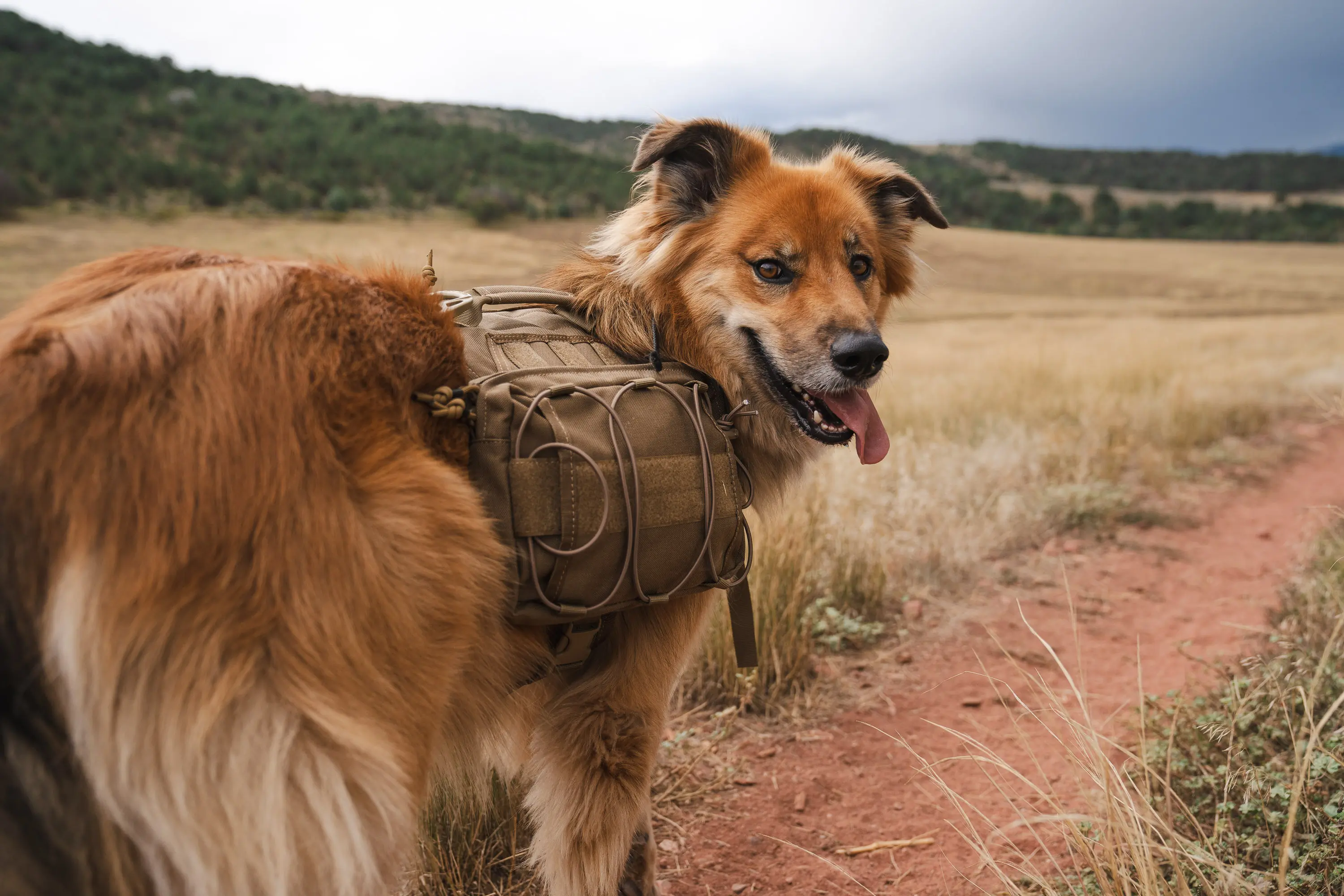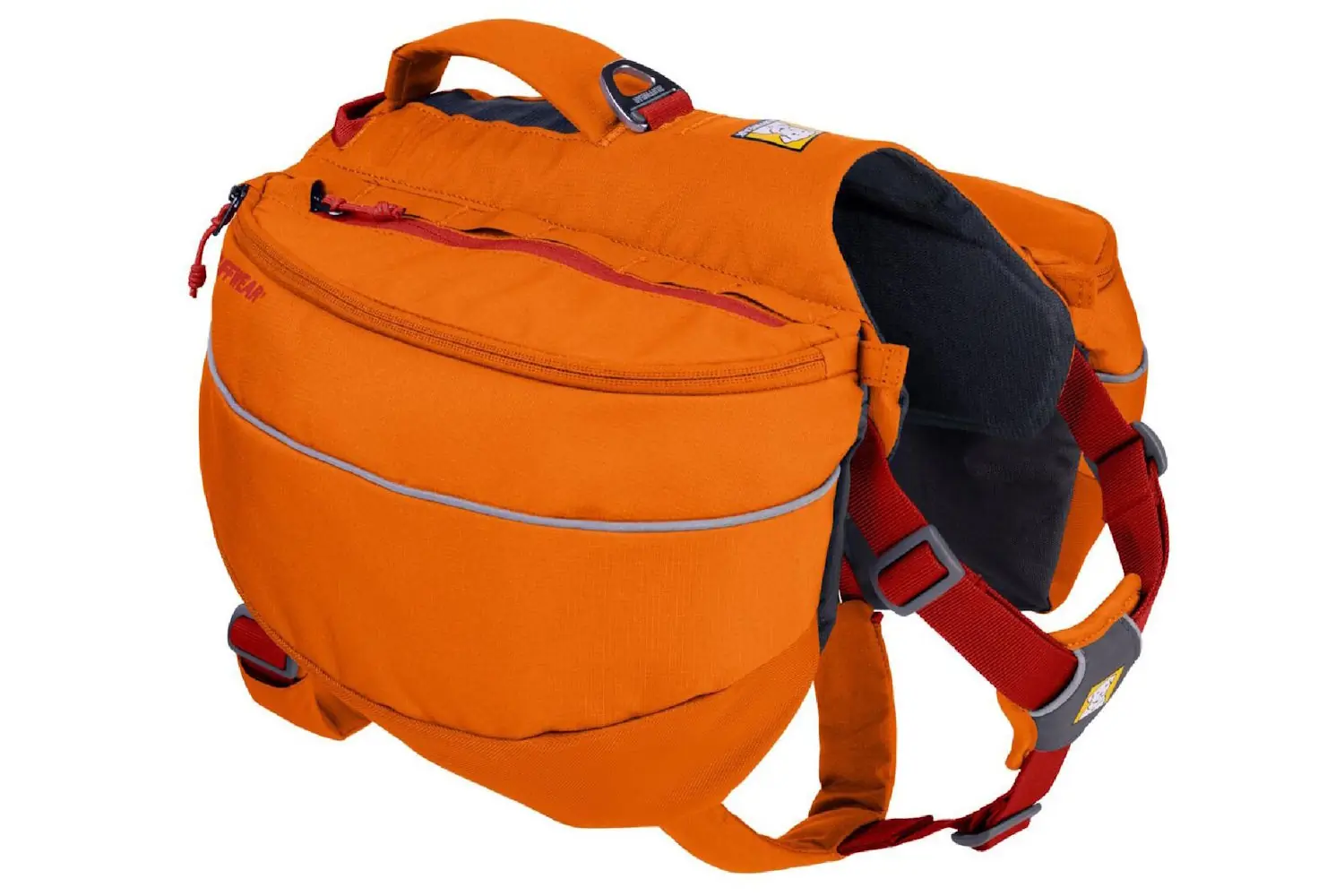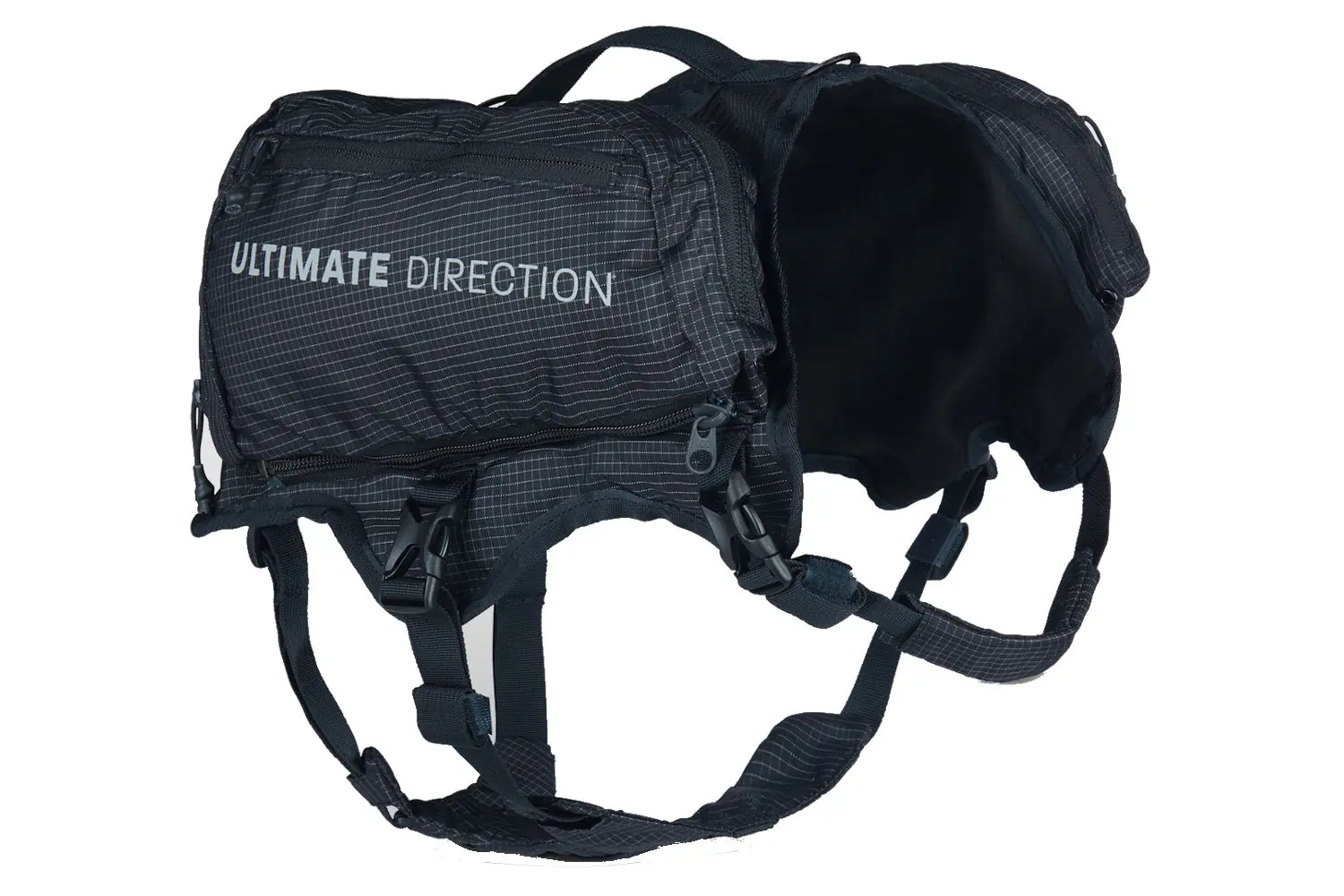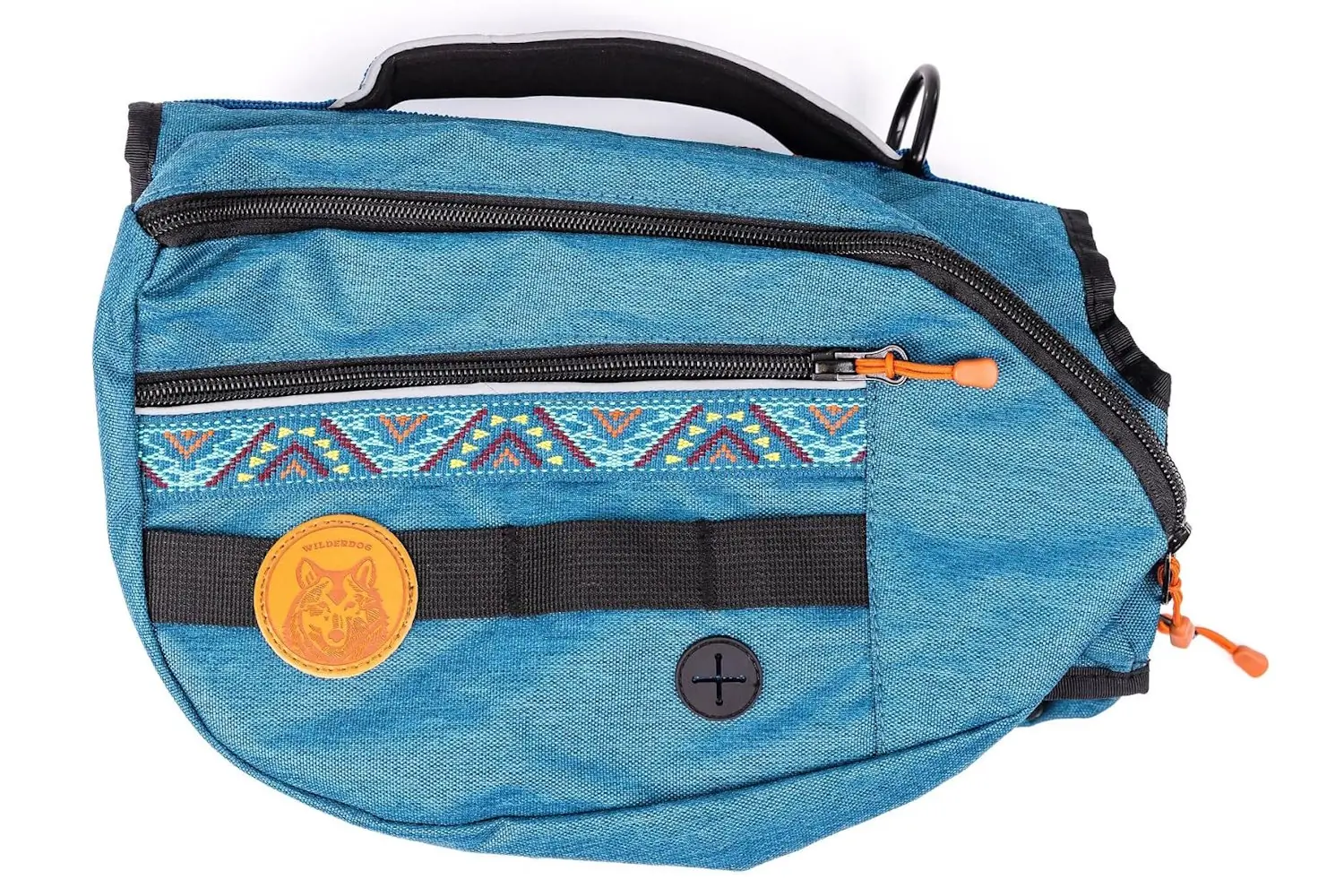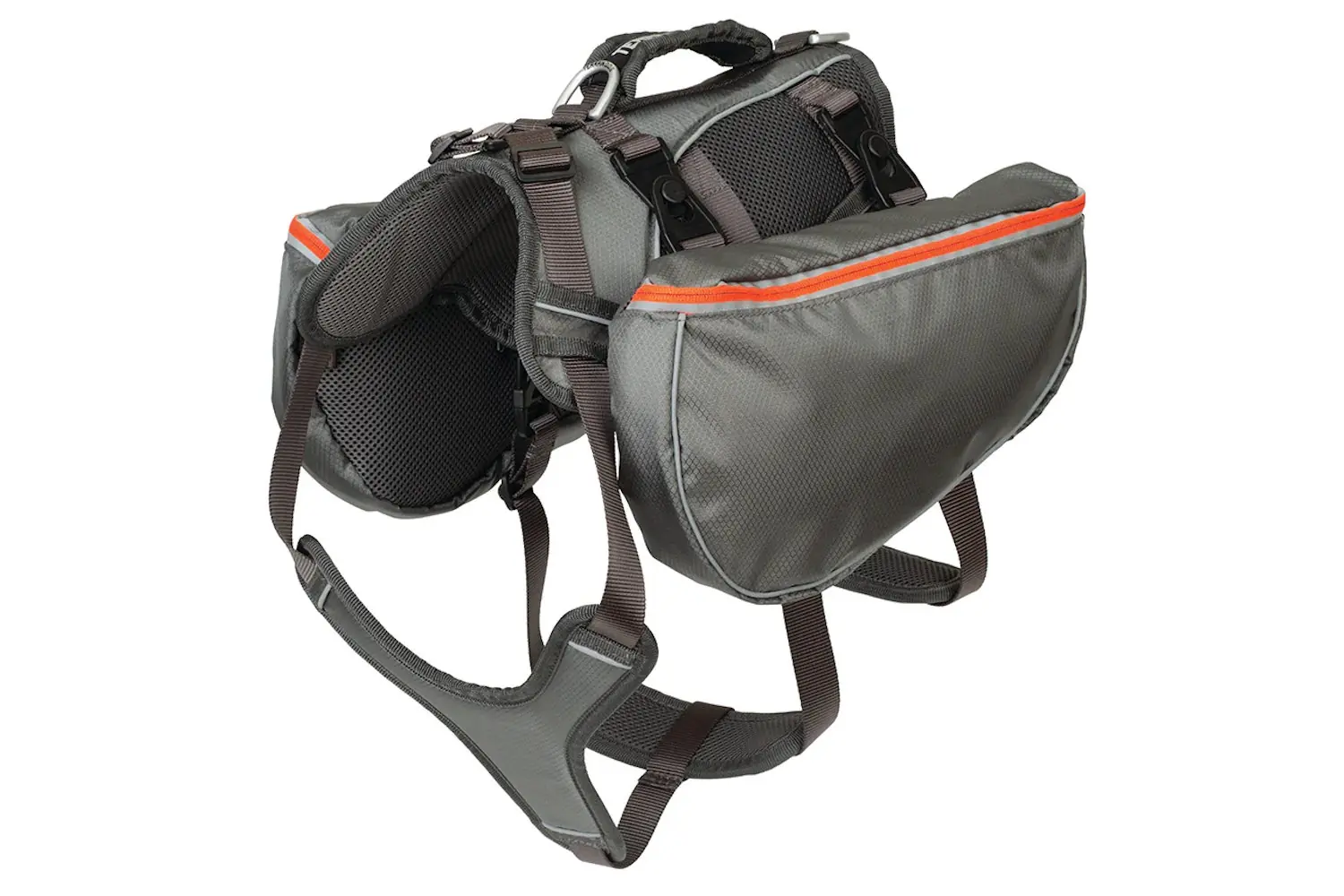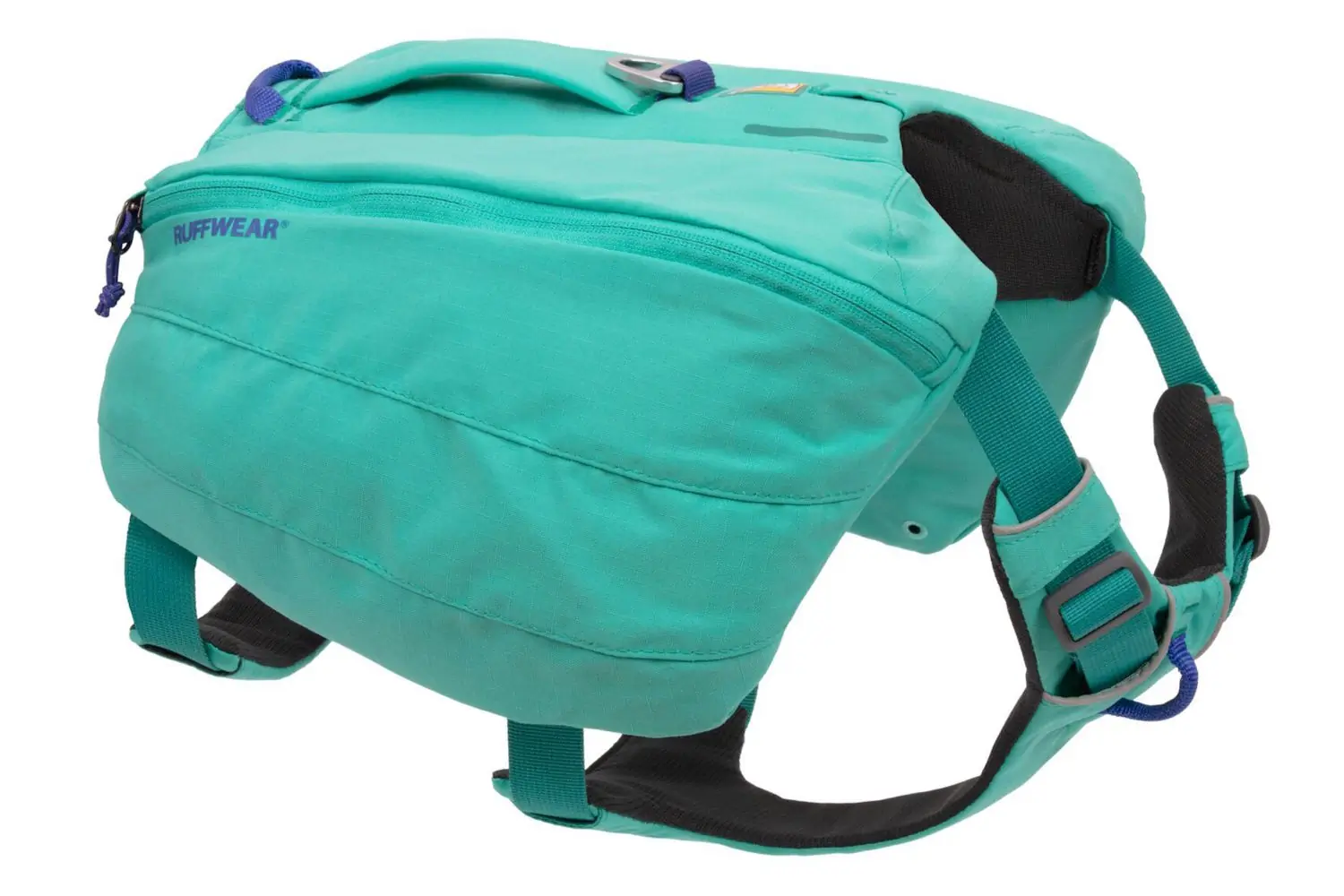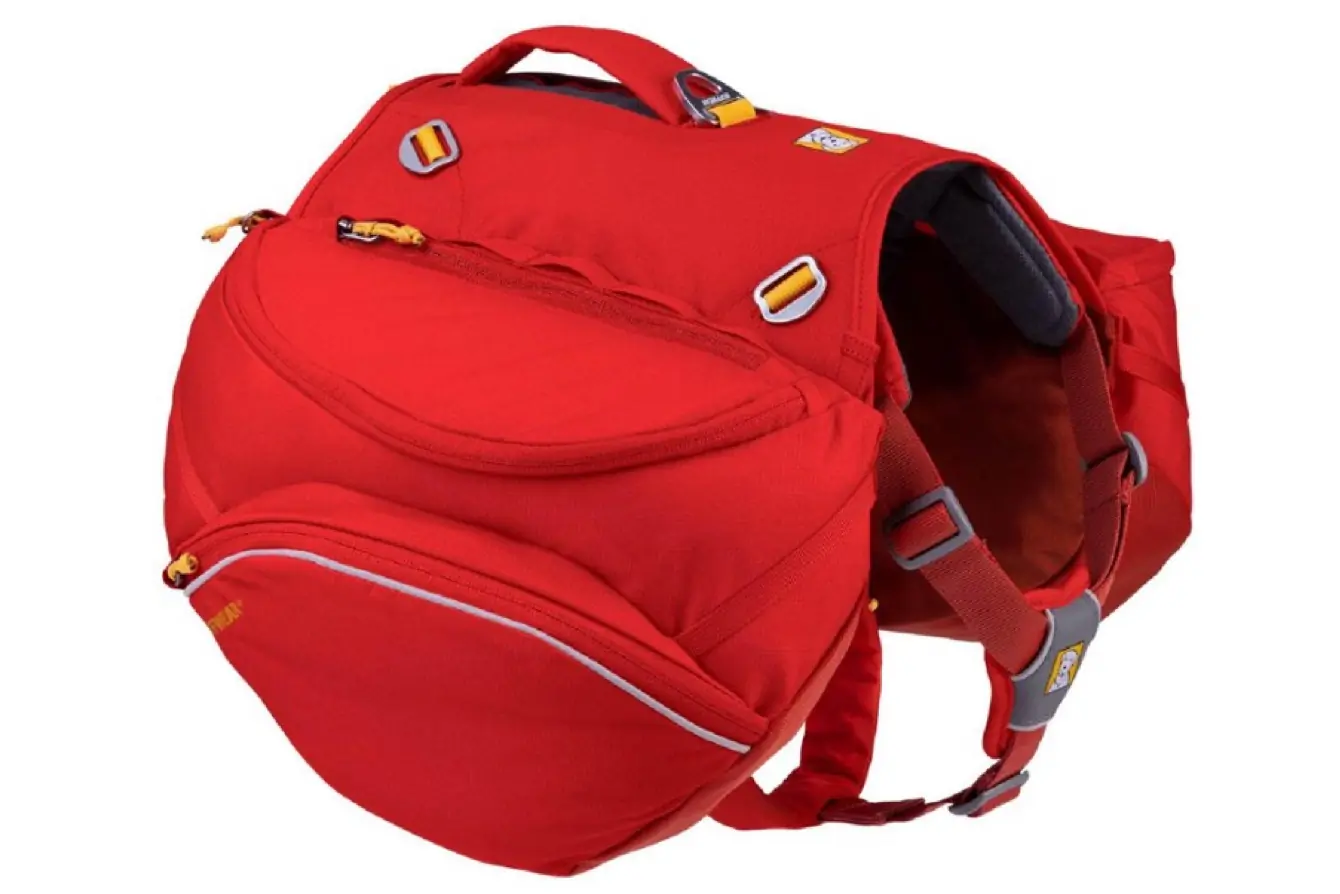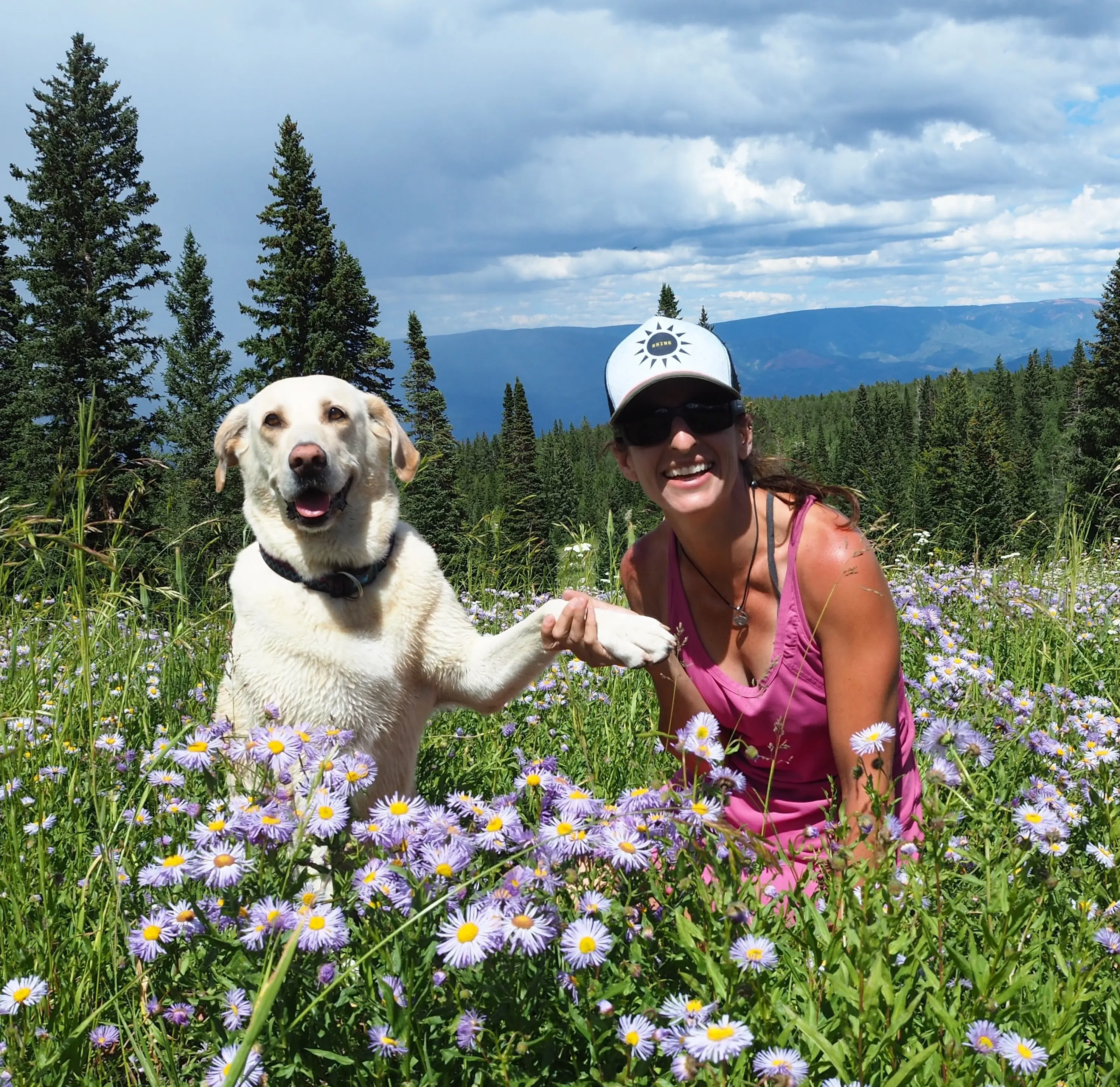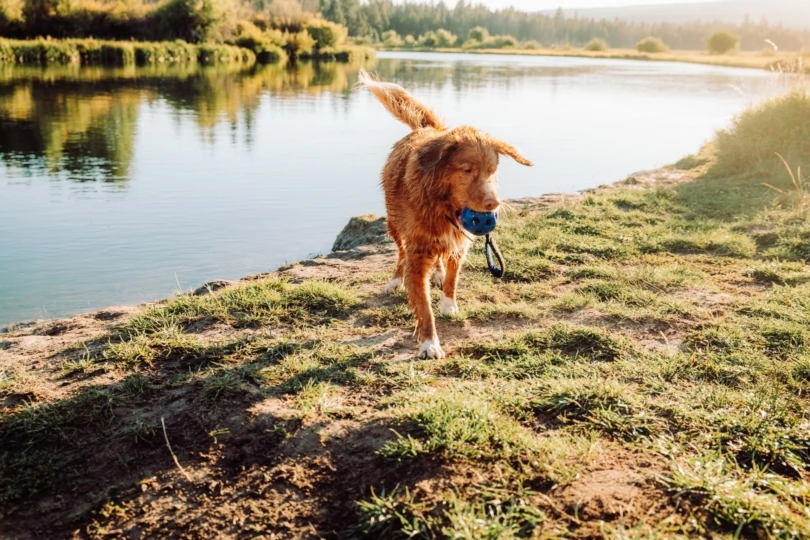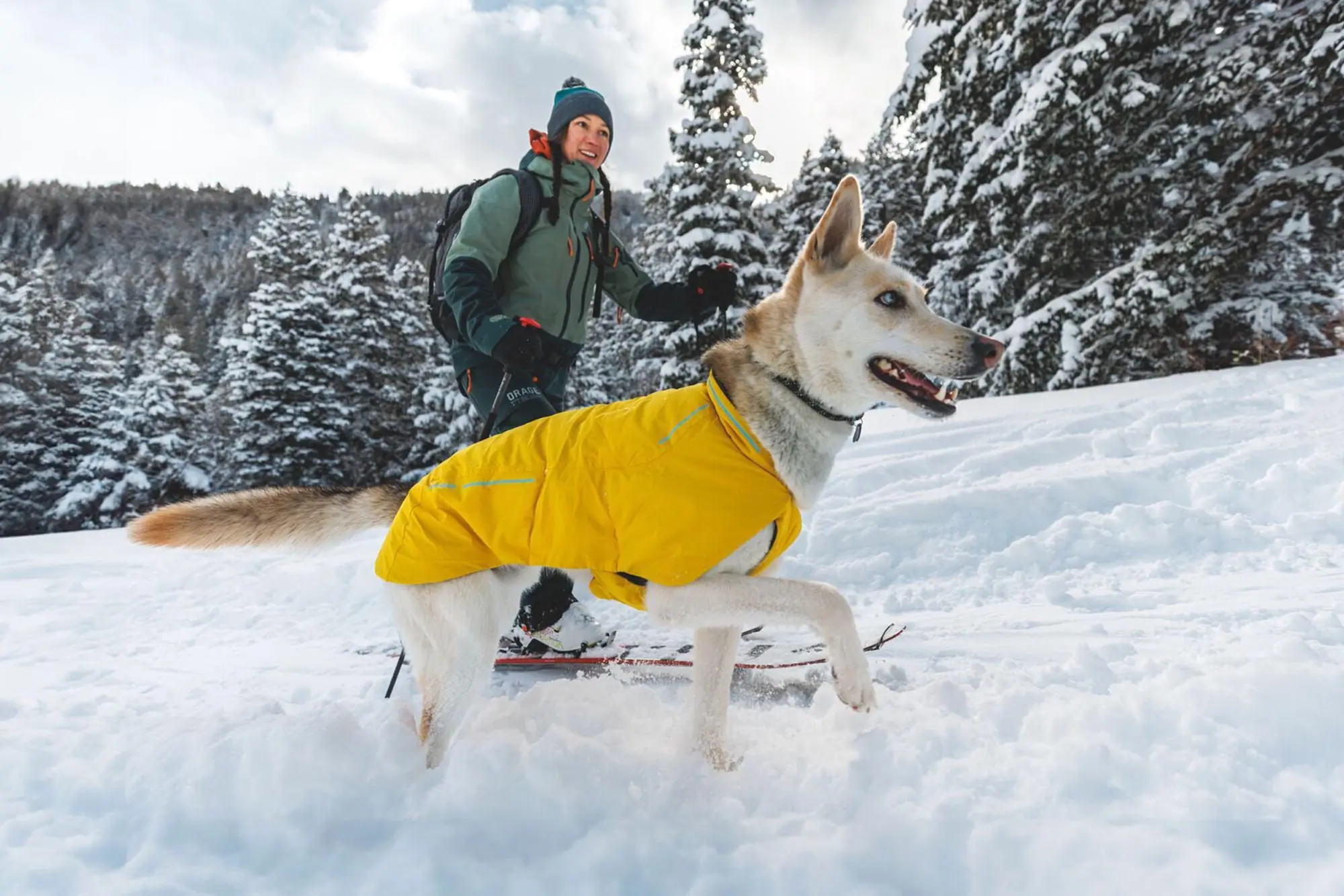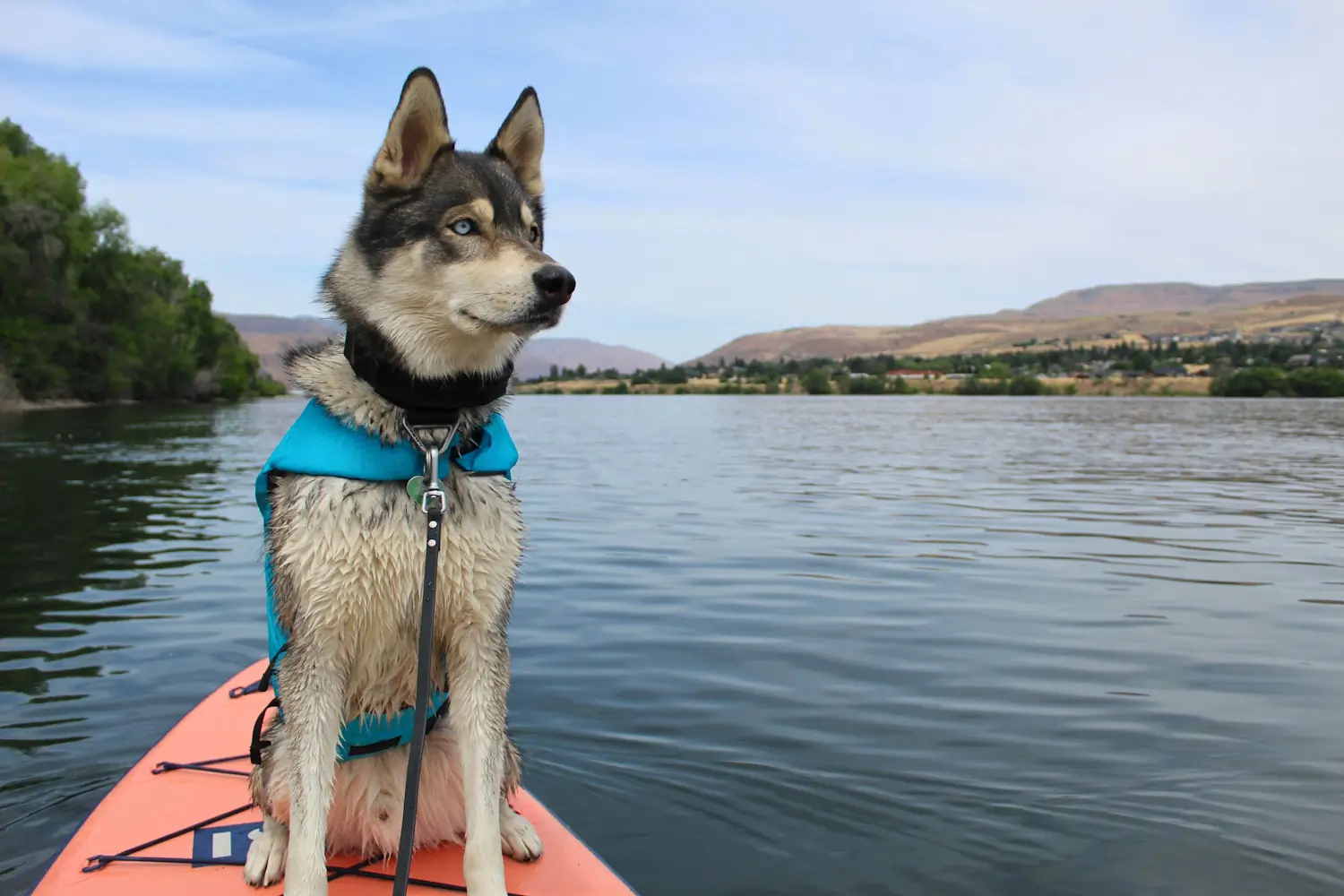Dog backpacks are more than cute accessories — they allow your pooch to haul adventure necessities like food and water. Whether you’re heading out for a rugged day hike, a weekend backpacking trip, or just a stroll around the neighborhood, the best dog backpacks can make the journey smoother for both you and your four-legged friend.
Our lead tester, Meghan LaHatte, put these packs through the wringer with the help of her pup, Opa. GearJunkie Editor, Chris Kassar, and her pup, Nala, also put a few backpacks to the test. These pairs frolicked through miles of Wyoming and Colorado backcountry, carefully assessing the comfort, functionality, and durability of numerous dog pack styles.
The Ruffwear Approach Dog Pack ranked as our best overall because it’s simple, comfortable, and durable. If you’re looking for something lighter that’s ideal for your running partner, consider the Ultimate Direction Dog Vest.
Editor’s Note: We updated our Dog Backpacks guide on May 15, 2025, by updating information on our testing procedures. and adding the freshly field-tested Himal Outdoors Dog Backpack, which received our best budget award.
The Best Dog Backpacks of 2025
Ruffwear Approach Dog Pack
- Volume: 6 L, 12.5 L, 14.5 L, 24 L
- Weight: 12.8 oz., 1 lb. 1 oz., 1 lb. 2 oz., 1 lb. 5 oz.
- Chest girth: 17" – 42"
- Number of pockets: Four
Pros
- Roomy
- Reflective trim
- Easily adjustable
- Small top pockets for easy access
Cons
- Minimal padding on the chest strap
Himal Outdoors Dog Backpack
- Volume: N/A
- Weight: 15.8 ounces
- Chest girth: 27.5" – 34.6"
- Number of pockets: Four
Pros
- Affordable
- Durable
- Spacious pockets
- Adjustable fit
- Built-in handle for control or assistance
Cons
- Not waterproof
- Fit may shift on some dogs
- Only one size available
Ultimate Direction Dog Vest
- Volume: 5.8 L, 8.6 L, 10.3 L
- Weight: 11 oz.
- Chest girth: 22" – 42"
- Number of pockets: Four
Pros
- Lightweight
- Bowl included
- Can hold up to 2 L of water
Cons
- No padding on straps
OneTigris Mammoth Dog Backpack
- Volume: 6 L
- Weight: S: 14.6 oz. / L: 16 oz.
- Chest girth: 20” – 36”
- Number of pockets: 2 interior and 2 exterior bungee pockets
Pros
- Durable material
- Large straps and buckles are easy to maneuver
- Decent capacity with outer bungee pockets and velcro attachments
Cons
- Exterior bungees can get caught on branches or fences
- Design may be too cumbersome for smaller dogs
Wilderdog Dog Backpack
- Volume: 5 L, 8 L, 12 L
- Weight: 9.5 oz., 12.9 oz., 14.5 oz.
- Chest girth: 17” – 34”
- Number of pockets: 4
Pros
- Simple, streamlined design makes for easy on and off
- Internal accessories like a poop bag holder provide convenience
- Durable material makeup and strap design
Cons
- Sizing options more limited
- Pocket sizes may be too cumbersome for some dogs
- Lack of padding on underside straps
Terrain Dog Lightweight Adventure Pack
- Volume: Unavailable
- Weight: 1 lb. 3 oz. (size large)
- Chest girth: 17”– 45”
- Number of pockets: 2
Pros
- Removable packs maks it easy to transform from a backpack to a harness
- Mesh padding throughout straps and chest area
- Reflective elements increase visibility
Cons
- Harness is a bit heavy
- Adjust system is complex
- Saddle bags will flop around a bit
Other Dog Backpacks We’re Wild About
- Volume: 4.5 L, 8 L, 10.5 L, 18.5 L
- Weight: 11.2 oz., 15.2 oz., 1 lb. 0.8 oz.,1 lb. 5.6 oz.
- Chest girth: 17"-42”
- Number of pockets: 2
Pros
- Easy fit with 5 points of adjustment
- Three leash attachment points
- Plenty of room for necessary supplies
Cons
- Limited color schemes in new design
- A bit large for a day pack
- Volume: 3.75 L, 7.5 L
- Weight: 14 oz., 1 lb. 4 oz.
- Chest girth: 27" – 40"
- Number of pockets: Two
Pros
- Padded spine
- Roomy saddlebags
Cons
- Not waterproof
- Straps need extra cinching for narrow-chested dogs
- Volume: 7 L, 12 L, 16 L
- Weight: 15 oz., 1 lb., 1 lb. 3 oz.
- Chest girth fit: 20" – 40"
- Number of pockets: Two
Pros
- Tons of pack space
- Padded sternum
- Lots of adjustments
Cons
- Water-resistant, not waterproof
- Volume: Unavailable
- Weight: 10.8 oz.
- Chest girth: 21" – 32"
- Number of pockets: Four
Pros
- Price
- Simplistic design
Cons
- No chest padding
- Open stash pockets
- Only two size options
- Volume: 12.5 L, 17.5 L, 24 L
- Weight: 1 lb. 12 oz., 1 lb. 14 oz., 2 lb. 2 oz.
- Chest girth: 22" – 42"
- Number of pockets: Four
Pros
- Collapsible water pouches included
- Third belly strap
- Removable saddlebags
Cons
- Pricey
- Volume: Unavailable
- Weight: 12 oz. (small)
- Chest girth: 22.8" – 35"
- Number of pockets: Two
Pros
- Durable yet lightweight
- Affordable
- Good quality zippers
Cons
- Not ideal for use as a harness
- Only two pockets
Dog Backpacks Comparison Chart
| Dog Backpack | Volume | Weight | Chest Girth | Number of Pockets |
|---|---|---|---|---|
| Ruffwear Approach Dog Pack | 6 L, 12.5 L, 14.5 L, 24 L | 12.8 oz., 1 lb. 1 oz., 1 lb. 2 oz., 1 lb. 5 oz. | 17-42″ | 4 |
| Himal Outdoors Dog Backpack | N/A | 15.8 oz. | 27.5″ – 34.6″ | 4 |
| Ultimate Direction Dog Vest | 5.8 L, 8.6 L, 10.3 L | 11 oz. | 22-42″ | 4 |
| OneTigris Mammoth Dog Pack | 6 L | S: 14.6 oz. / L: 16 oz. | 20-36” | 2 interior , 2 exterior |
| Wilderdog Dog Backpack | $69 | 9.5 oz.; 12.9 oz., 14.5 oz. | 17-34″ | 4 |
| Terrain Dog Lightweight Adventure Pack | $64 | 1 lb., 3 oz. | 17-45″ | 2 |
| Ruffwear Front Range Day Pack | 4.5 L, 8 L, 10.5 L, 18.5 L | 11.2 oz., 15.2 oz., 1 lb. 0.8 oz.,1 lb. 5.6 oz. | 17- 42” | 2 |
| Kurgo Baxter Pack | 3.75 L, 7.5 L | 14 oz., 1 lb. 4 oz. | 27-40″ | 2 |
| Mountainsmith K-9 Dog Pack | 7 L, 12 L, 16 L | 15 oz., 1 lb., 1 lb. 3 oz. | 20-40″ | 2 |
| Outward Hound Day Pack Dog Backpack | Unavailable | 10.8 oz. | 21-32″ | 4 |
| Ruffwear Palisades Dog Pack | 12.5 L, 17.5 L, 24 L | 1 lb. 12 oz., 1 lb. 14 oz., 2 lb. 2 oz. | 22-42″ | 4 |
| Lifeunion Adjustable Service Dog Supply Backpack | Unavailable | 12 oz. (small) | 22.8-35″ | 2 |
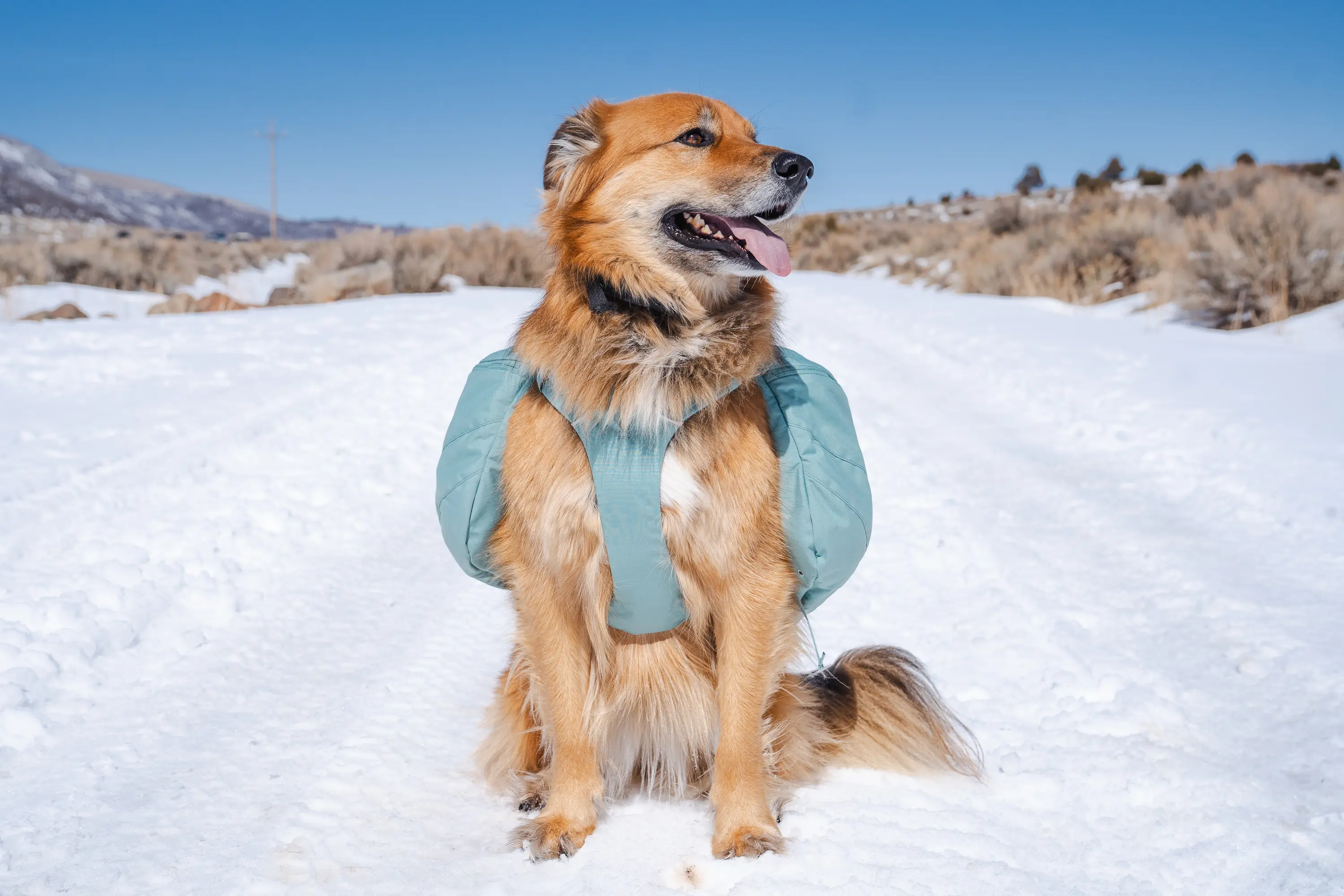
How We Tested Dog Backpacks
Our Expert Testers
We love our pups here at GearJunkie. And there’s nothing more we love than bringing them along on our excursions, which is why we’ve put good effort into finding the perfect dog backpacks so they can carry a bit of their own kit on the go. No dog is the same as the next, which is why we’ve tested dog packs from across the spectrum to find a pup backpack that’ll work for any furry best friend.
Leading the testing front for this guide is Meghan LaHatte, a contributing writer based in Colorado. Growing up, Meghan can’t recall a day when she didn’t have a dog by her side. This holds true even now, with her two rescues, Opa and Ellie, both large shepherd mixes.
As an avid adventurer who loves to hike and backpack with her four-legged friends, Meghan understands the importance of having the best dog backpack and what works best for different breeds and personalities.
Our Testing Grounds & Process
While testing these packs, we paid special attention to how our pups carried a load, knowing that an uneven carry can be an uncomfortable way for your dog to spend a day. We also noted overall capacity, padding, and comfort, as well as the trustworthiness of the leash attachments, which can all make or break a good dog backpack.
Much of our testing took place while hiking and climbing in Colorado. After miles of trail (and a good number of treats), we’ve assembled our list of the best dog backpacks available today. As new packs hit the market, we’ll saddle up our pups for testing and update our list with the latest and greatest to hit the trails. If you want to fully kit out your dog, check out our guides to the best dog collars, dog leashes, and dog life jackets.
Buyer’s Guide: How to Choose the Best Dog Backpack
There’s a lot to consider when purchasing a pack for your best buddy. Read on for comprehensive advice on pack size, fit, value, and much more.
Capacity
The whole point of buying a backpack for your dog is so it can carry gear. So, getting a pack that can’t hold much more than a few poop bags doesn’t make sense.
A backpack with a 3 – 5L capacity, like the Ruffwear Front Range Day Pack, usually does the trick here. If you’ve got a beefy dog and you’re going on a multiday backpacking trip, consider a larger pack. We’ve got packs on this list that can go up to 24 L in capacity. For example, the Ruffwear Approach Dog Pack should provide enough space to carry everything your dog needs.
Load Dispersion
Your dog is not going to enjoy carrying an uneven load. If their pack carries weight unevenly in any direction, your dog will, at best, be uncomfortable. At worst, this can cause an injury. Look for a pack that carries its load evenly on both sides.
Also, make sure the weight is carried well from front to back. Any good dog backpack has even capacity on both sides and carries the weight closer to the shoulders for solid support. Due to its compression straps, we were especially impressed by the load dispersion on Ruffwear’s Palisades Dog Pack.
Weight
As a general rule of thumb, a dog should carry no more than 25% of its body weight. Keep in mind that number is the maximum amount. Depending on your dog’s age and fitness level, this number can vary from 10% up to 25%.
Some breeds are better at carrying more weight. Puppies and senior dogs are going to need lighter loads. Keep an eye on your dog while you hike. If it looks like he’s flagging or uncomfortable, be ready to take some of his load and carry it in your pack.
If you are worried about overbearing your pup with weight on that next adventure, try grabbing a backpack with removable saddle bags like the Terrain Dog Lightweight Adventure Pack. This will allow you to remove the bags for periodic breaks without having to take off the entire harness.




Leash Attachment Points
Whether or not you let your four-legged buddy run free on the trail, there will be times when you need to put a leash on. Ensure the pack you buy for your dog has at least one attachment point. Many have two points of attachment — one near the shoulder blades and one on the back near the tail.
And while it only has one leash attachment point, we were ultimately impressed by the Lifeunion Saddle Bag backpack for its super tough rear D-ring.
Many people prefer to use the leash attachment on the front because some dogs tend to pull more when the leash is closer to the dog’s tail. For shorter walks and day trips, consider the simplicity of a dog harness.
Fit & Comfort
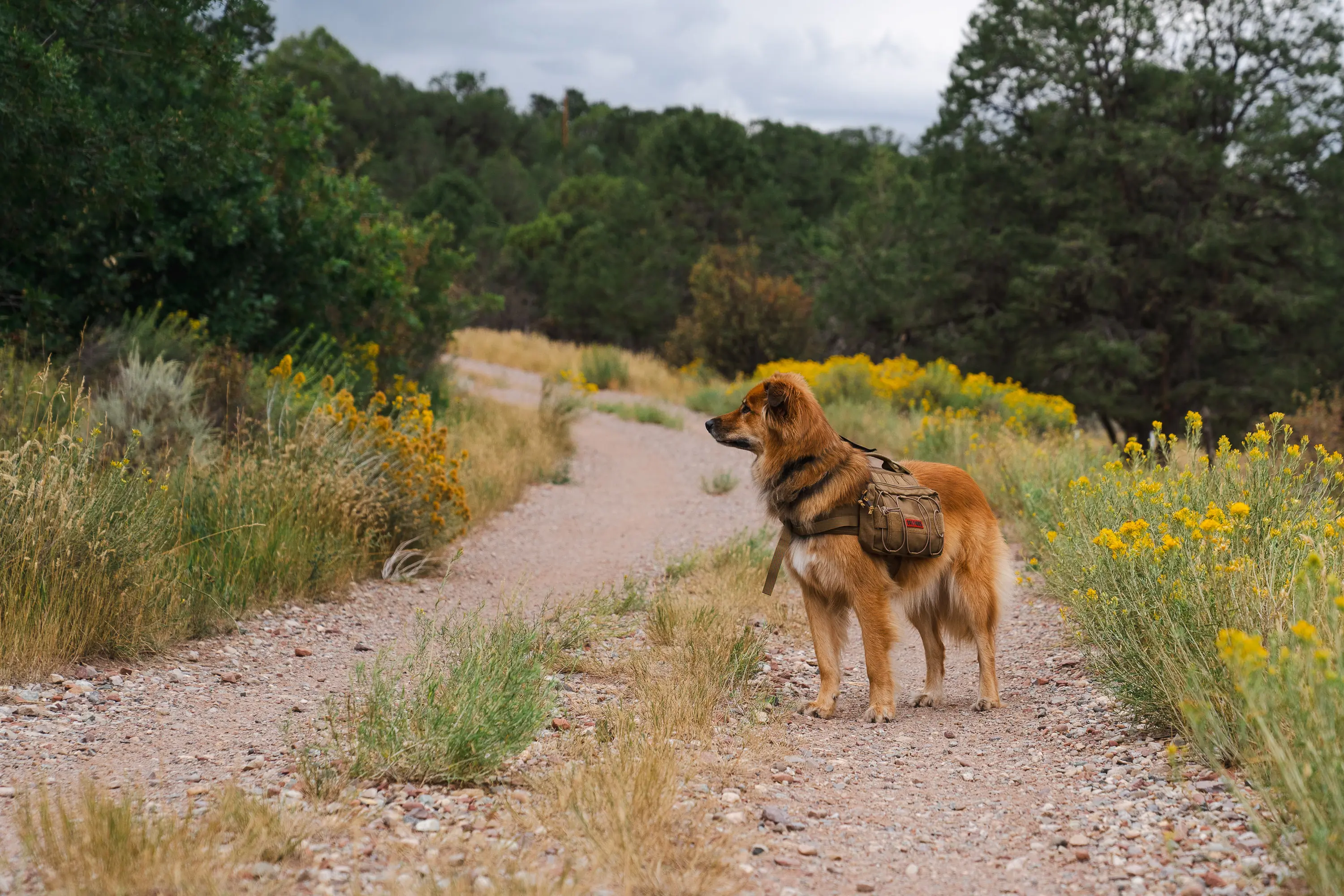



Your first concern when shopping for a pack is making sure your dog is comfortable. Look for features like padded straps and mesh material. The padded straps help reduce chafing and irritation during longer hikes. The mesh or sweat-wicking material helps protect your dog from overheating.
Make sure the load is distributed evenly so your dog doesn’t have to compensate for it on the hike. The biggest factor in preventing discomfort is making sure the pack fits your dog.
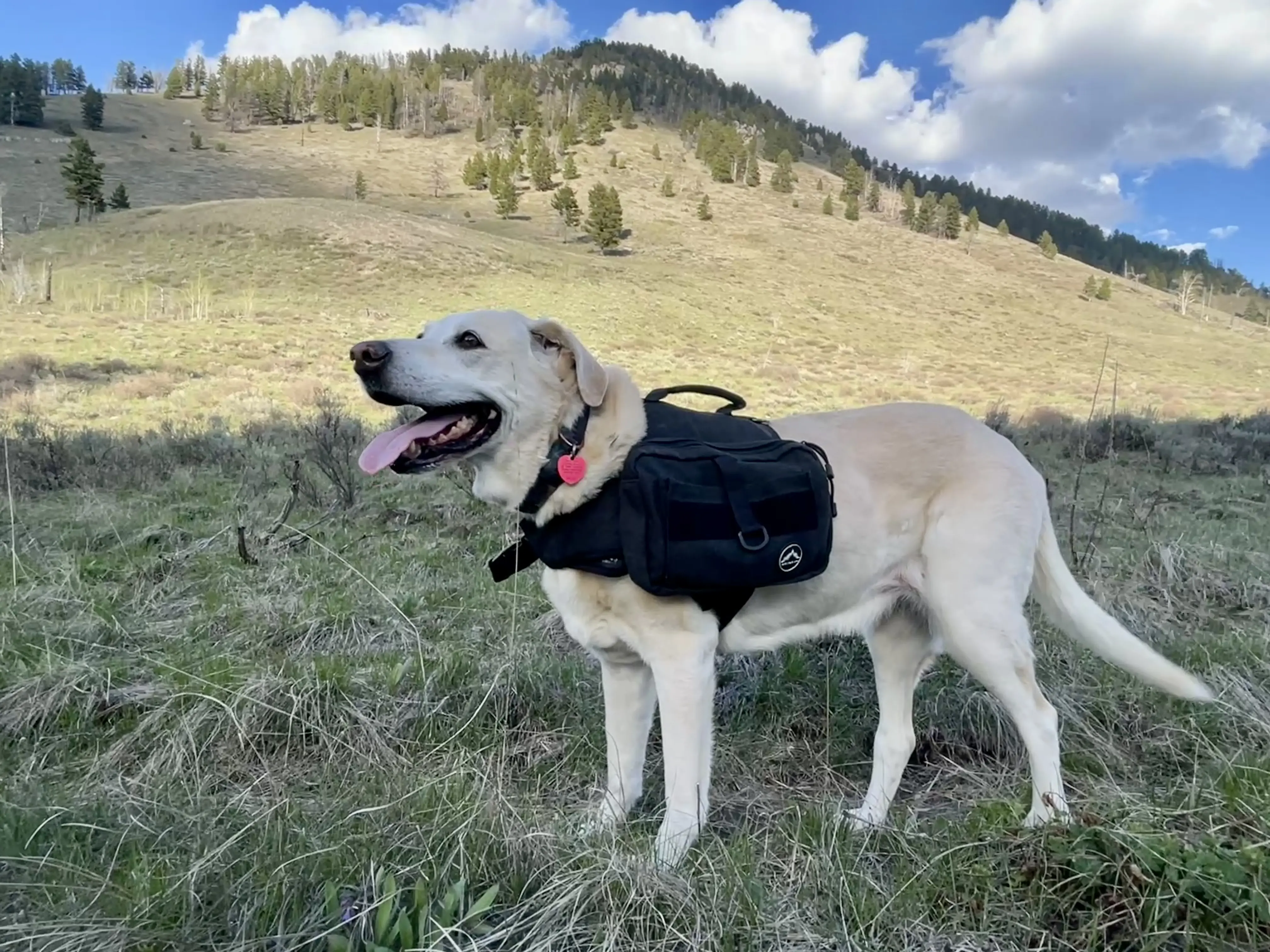



How to Measure Your Dog for a Backpack
Most websites list the varying sizes and associate them with a dog’s weight. However, dogs come in all shapes and sizes. The best way to fit your dog is to get the proper measurements.
Use a piece of string or a flexible tape measure to find the circumference of your dog’s upper neck, lower neck, and chest. After that, measure your dog’s length from the tail to the chest.
Compare those measurements to the dog pack you’re considering to find the right size. Keep in mind that some packs won’t work for certain dogs, like those with small necks and deep chests. Also, consider your dog’s coat thickness, as that can affect the fit and comfort of a dog pack.
When you get the pack, try it on your dog and adjust as necessary to make sure it fits. When fitting the pack, follow the two-finger rule. If the straps are snug but leave room for two fingers between the gear and your dog, it’s a good fit. Be sure to keep any fur out of the zippers or buckles to prevent any pinches or itchiness for your pooch.
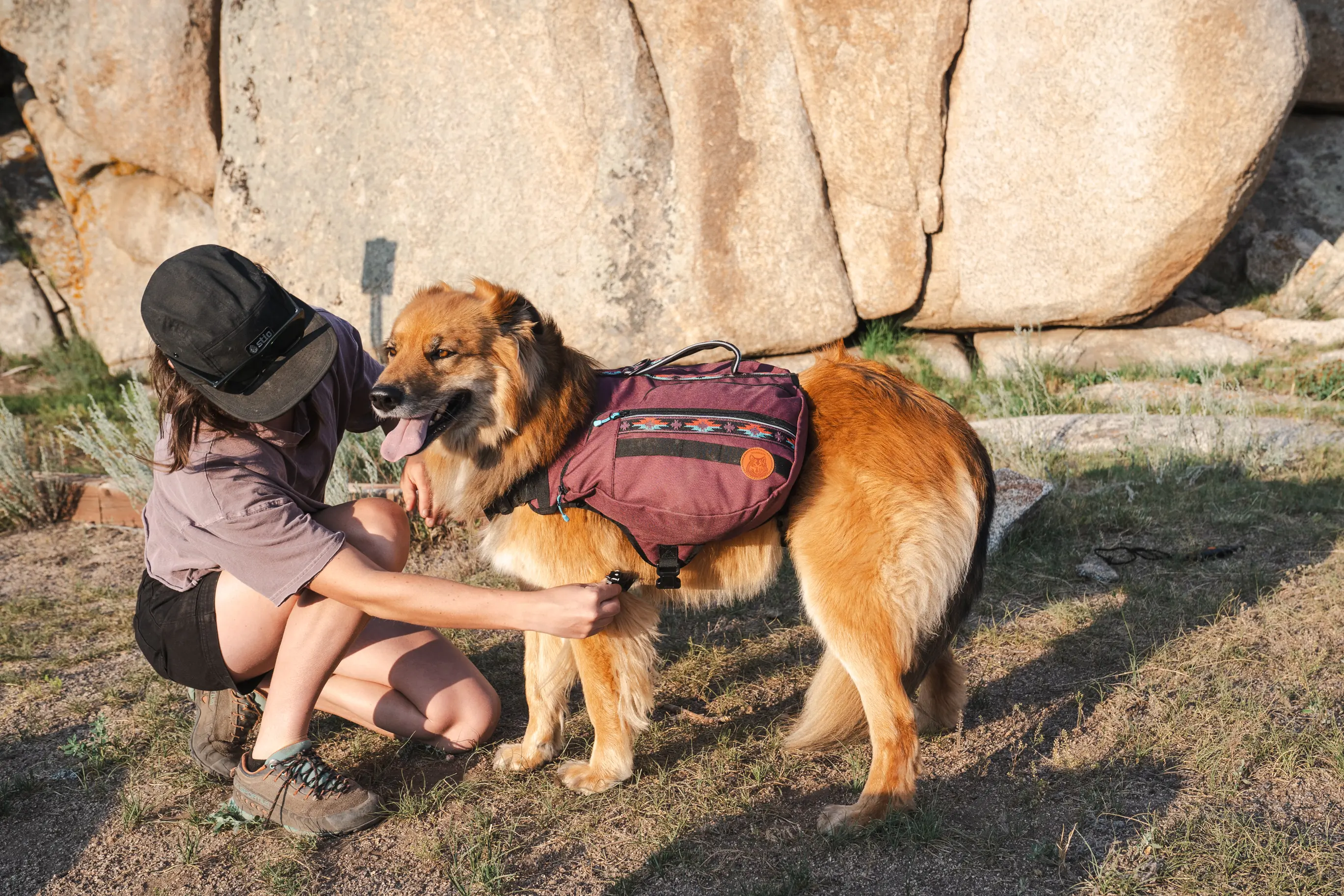



Tips for Using Dog Backpacks
Start With Short Hikes & Low Weight
No matter how fit your dog is, carrying a lot of weight over a long distance right away will come as a shock. Just like training for a long run, it’s good to ease your dog into carrying a pack. If you find your dog is wary or skittish of putting the backpack on, try giving it treats and positive reinforcement when pulling the pack out for use.
Once on, start with short walks with an empty backpack. This will help your dog get used to wearing a pack. Then, add weight and distance as you go.
If you’re planning a specific trip, it’s a good idea to work your way up to distances and weights close to what your dog will carry on the trip. As the trip date approaches, keep adding distance and weight. This can go a long way toward ensuring that your furry friend enjoys his time outside.
Keep It Snug & Secure
Nothing can ruin your hike like chafing and irritation. The same goes for your dog. Make sure the pack fits properly and securely, following the two-finger rule above.
Straps can loosen as you hike. Make sure you check your dog’s straps occasionally and adjust them as necessary.
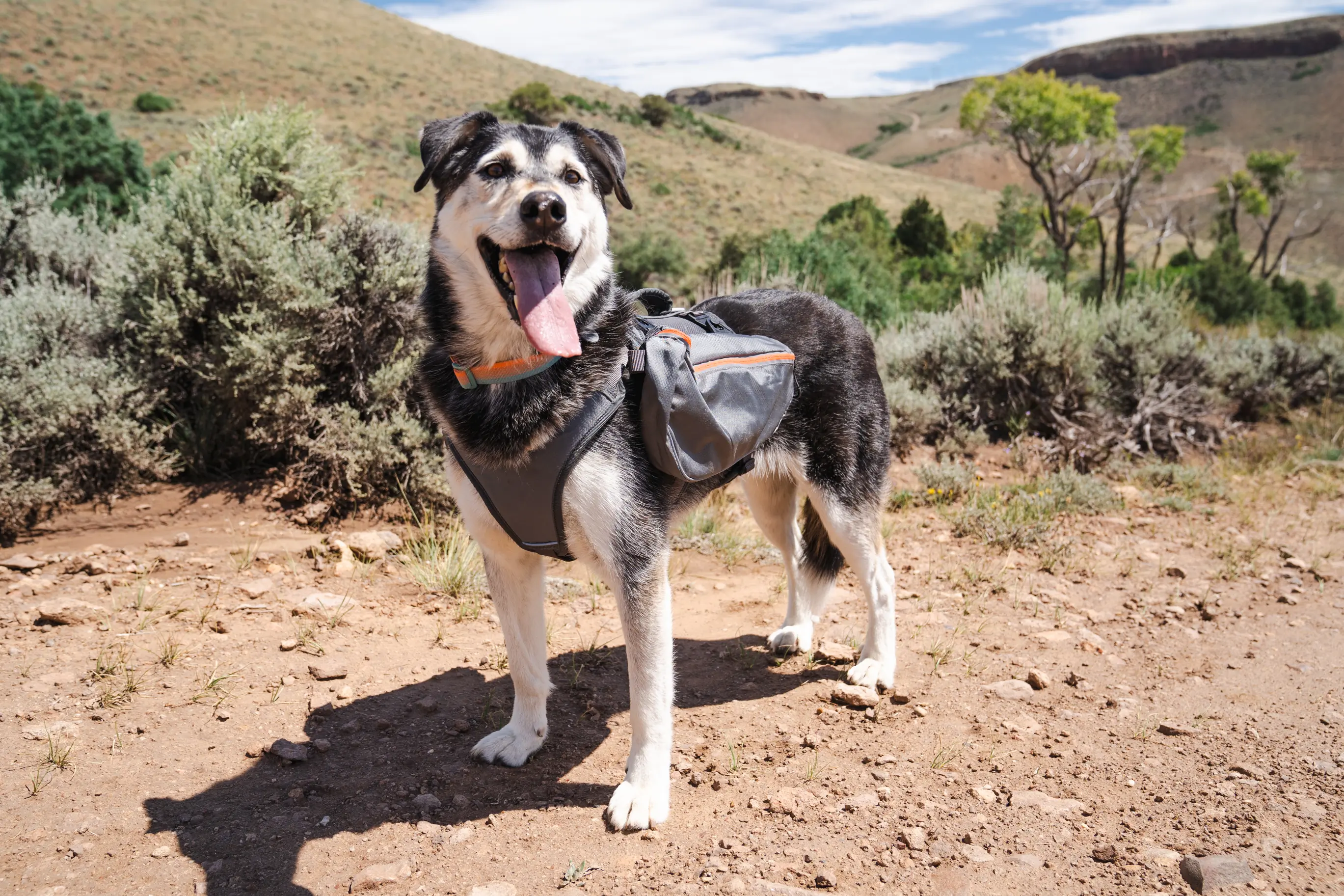



Pick the Right Size Pack
A huge part of avoiding chafing and hot spots is ensuring your dog’s pack is the right size. Most websites offer different sizes according to weight. This is a good start.
Compare the specs listed on the pack’s website to ensure a good fit. Then, when you get the pack, check its fit before you go out.
Adjust the straps so you can fit two fingers between your dog and the strap. This ensures a snug fit that isn’t too tight.
Know Your Dog
Weight and size are only two factors when deciding on the right pack for your dog. When shopping around, consider factors like age and health.
Puppies and senior dogs need to carry less weight. Consider a smaller pack that can hold around 10-15% of your dog’s weight. The same goes for if your dog is out of shape or recovering from sickness or injury.
Disposition is also a factor. If you have a more rambunctious dog, consider a burlier harness and a sturdy top handle. This will help you keep control of your dog if you encounter other animals on the trail.
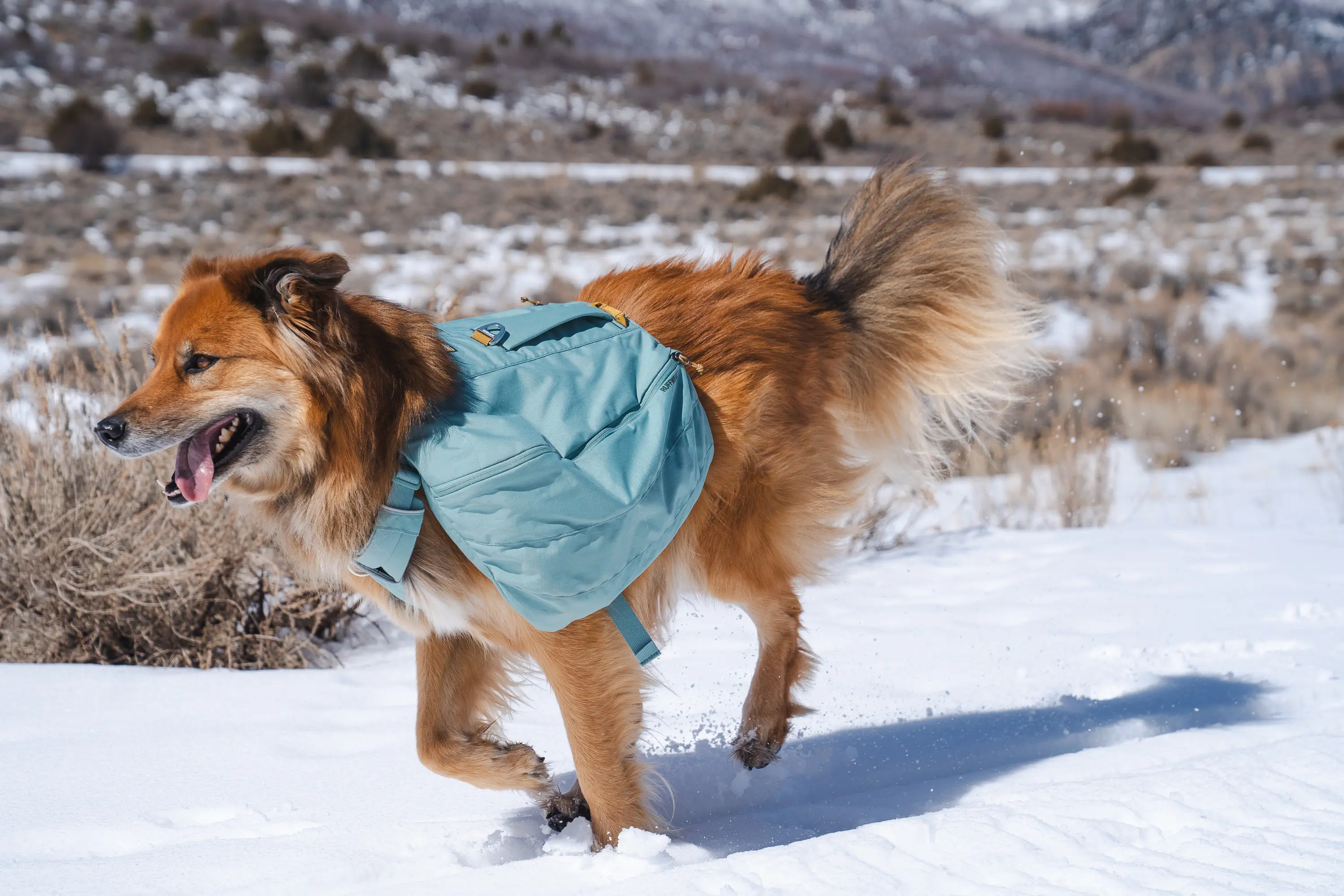



Price & Value
Of course, shop for a dog backpack that fits within your budget. In general, more expensive packs tend to have more bells and whistles. But there are many quality packs in the mid-to-low price range. Expect to spend from $75 to $100 for a comfortable, durable pack that sports some solid features. Larger, more feature-rich packs can cost closer to $150.
Budget
At less than 40 bucks, these backpacks are great for day hikes and lighter use. Our top budget pick, the Himal Outdoors Dog Backpack ($30), is also one of the most durable, and it has a lot of room and some handy features.
Mid-Tier
Expect to spend $60 to $100 for a comfortable, durable pack with solid features. Packs such as our top value pick, the Wilderdog Dog Backpack ($69), and our best overall pick, the Ruffwear Approach Dog Pack ($99), fall in this range. They’re long-lasting, easily and highly adjustable, and extremely comfortable so Fido can adventure for the long haul.
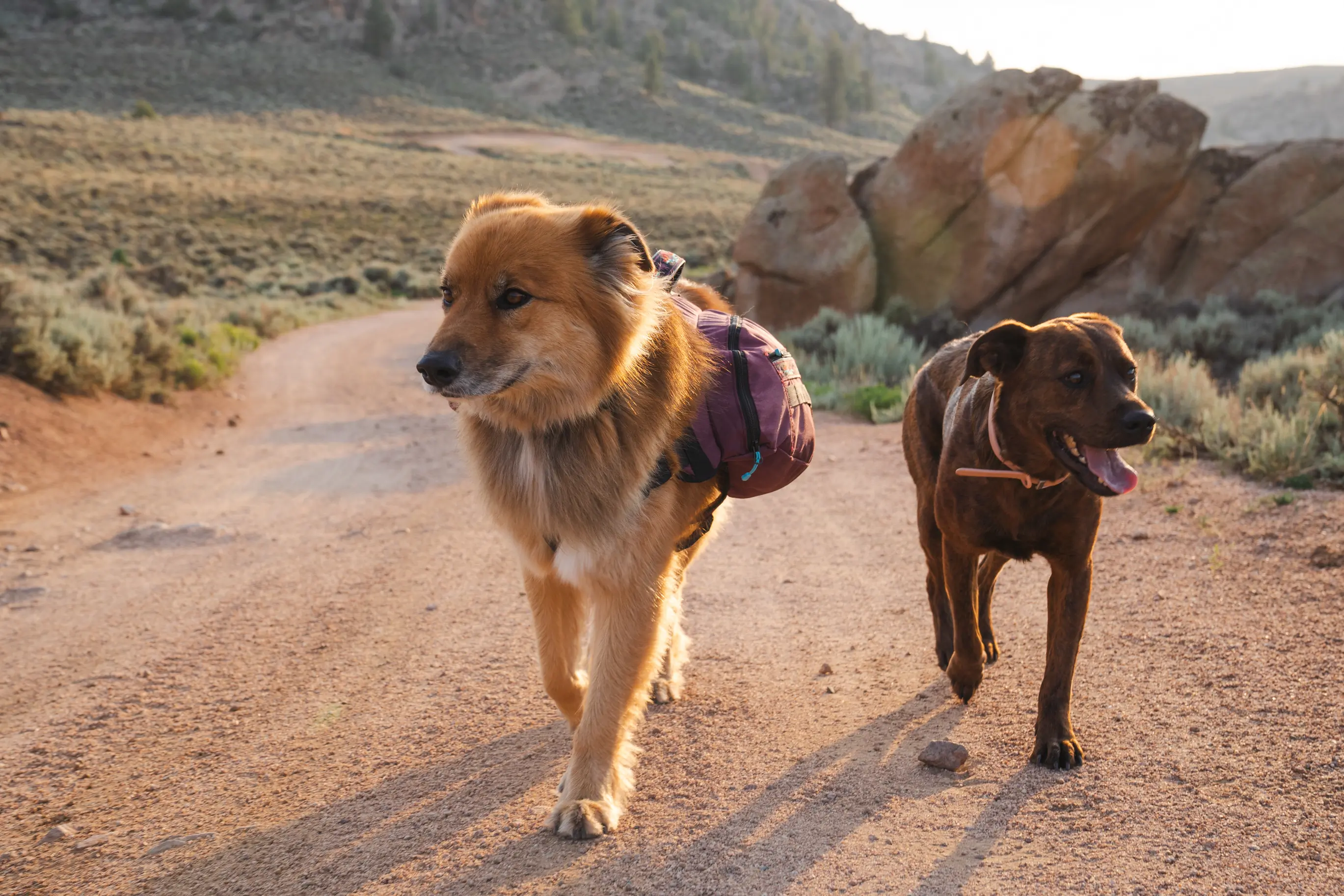



Premium
Larger, more feature-rich packs like the Ruffwear’s Palisades Dog Pack can cost closer to $150. It offers large capacity carrying options, comfort and visibility features. However, if you’re not going on multi-day adventures often, this may be overkill.
If you’re unsure what kind of pack to get for your dog, look at the budget options listed above. You can always start with an inexpensive pack and upgrade when you know what features you want. If you’re not sure what kind of pack to get for your dog,
Frequently Asked Questions
First and foremost, the best backpack is the one that fits each dog well. A good-fitting pack helps keep your dog comfortable on the trail. After that, make sure it can carry the right amount of weight for your dog’s ability.
A pack that won’t carry what you need for your pup won’t be very useful. Also, the best dog backpacks provide you with plenty of ways to control and secure your dog when the need arises.
Absolutely, but an ill-fitting or overweight pack can harm your dog. Make sure the weight and fit are right for your pooch before you head out.
The proper weight your dog can carry varies from 10% to 25% of your dog’s body weight. The variance depends mainly on your dog’s size, age, and fitness level. With the correct measurements, a little research, and a good fitting when you get your pack, you can ensure the right fit.
It varies, depending on how much your dog can carry. Waste bags and treats are some items even the smallest dog hiking backpack can hold.
If you have the room, extra food, water, and bowls are a great idea as well. You can even strap a rolled-up dog bed to some of the bigger packs.
The general rule is to never let your dog carry more than 25% of its weight. Depending on the dog, this can be as low as 10%. Senior dogs and puppies are going to be on the lower end of the spectrum.
As you hike, keep a close eye on your pooch. If he’s looking fatigued or is laboring under the weight, remove some gear and put it in your pack.
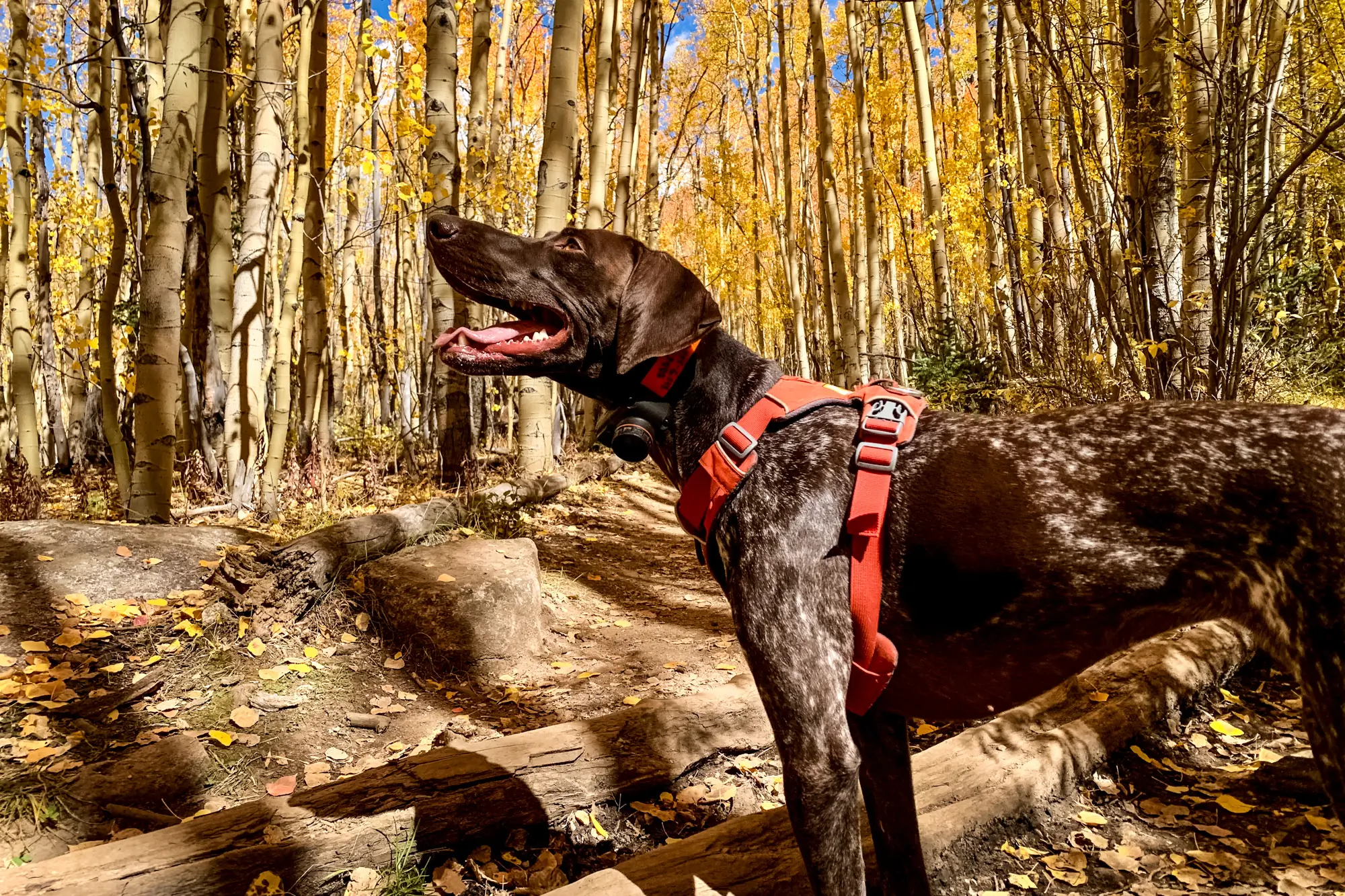

The Best Dog Harnesses of 2025
We tested the best dog harnesses from Ruffwear, Rabbitgoo, Voyager, and Atlas Pet Company to find the best option for your needs and budget


The 7 Best National Parks to Visit With Dogs
While a road trip to your favorite national park seems like the perfect opportunity to bring Fido, you may be surprised that most national parks aren’t incredibly dog-friendly. Here are the best ones that are.
